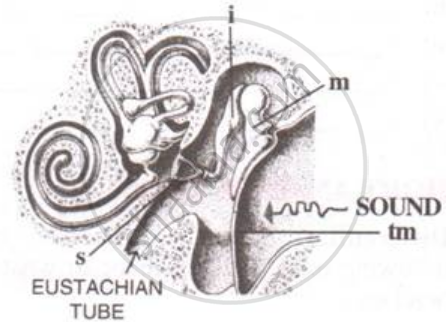Advertisements
Advertisements
Question
The figure below is the sectional view of a part of the skull showing s sense organ:

Name the sense organ.
Solution
Ear
APPEARS IN
RELATED QUESTIONS
Explain how the human ear works.
Which part of our body helps us in maintaining the body balance?
Explain the following:
Mechanism through which a sound produces a nerve impulse in the inner ear.
Given in the box below are a set of 14 biological terms. Of these, 12 can be paired into 6 matching pairs. Out of the six pairs, one has been done for you as an example.
Example : endosmosis - Turgid cell.
Identify the remaining five matching pairs :
| Cushing’s syndrome, Turgid cell, Iris, Free of rod and cone cells, Colour of eyes, Hypoglycemia, Active transport, Acrosome, Addison’s disease, Blind spot, Hyperglycemia, Spermatozoa, Endosmosis, Clotting of blood. |
Briefly explain the following terms: Power of accommodation
State the main function of the Suspensory ligament of the eye
The three parts of human ear contributing in hearing are-
Name the following:
The nerves which transmit impulse from ear to the brain.
Differentiate between members of the following pair with reference to what is asked in bracket.
Dynamic balance and static balance (Definition)
How could you convince a small child that when you speak, it is not necessary for air to travel from you mouth to the ear of listener?
There are three small bones in the muddle ear – anvil, hammer and stirrup :
(a) Which of these bones is in touch with ear-drum ?
(b) Which of these bones is in touch with oval window ?
The figure below is the sectional view of a part of the skull showing a sense organ:

Name the part labeled 'tm'. What is its function?
Differentiate between:
Cochlea and Concha.
Draw a labeled diagram of the inner ear. Name the part of the inner ear that is responsible for static balance in human beings.
Complete the following sentence with appropriate Word
The parts of the human ear concerned with hearing are :
The range of audible frequency for the human ear is
The Eardrum moves inward when a rarefaction reaches it.
Select the option with incorrect identification:

With reference to human ear answer the question that follow:
Name the part of the ear associated with dynamic balance.
